You may already be aware of the myriad advantages of yoga and meditation, yet have you contemplated the crucial impact that your footwear has on these practices? Barefoot shoes are meticulously crafted to replicate the natural movement of your feet, ensuring enhanced balance, increased flexibility, and a deeper connection to the earth. Imagine them as a yoga mat for your feet; they provide support while maintaining your contact with the ground. Unlike traditional shoes that can constrain, barefoot shoes encourage correct alignment and may help reduce injury risk, all whilst grounding your energy. Whether you are flowing through poses or embracing stillness, barefoot shoes can greatly elevate your mindfulness practice by synchronising you with the inherent stability of the earth.
Understanding the Benefits and Design of Barefoot Shoes
Your feet are engineered for natural movement, and barefoot shoes honour this design by imitating the sensation of walking barefoot while still safeguarding your feet. These shoes prioritise flexibility, thin soles, and a spacious toe box, allowing your feet to naturally expand and grip the ground, akin to how a yoga mat supports your practice. Wearing barefoot shoes boosts balance, proprioception, and grounding—critical elements for successful yoga and meditation.
Key Characteristics of Barefoot Shoes You Should Know
The philosophy behind barefoot shoes centres on a minimalist design. Typically, these shoes feature zero-drop soles (indicating no heel elevation), ultra-thin materials, and generous toe space, promoting unimpeded foot movement. Consider them a second skin that shields your feet whilst allowing for rich sensory feedback from the ground underneath.
The Historical Evolution of Barefoot Shoes
Barefoot shoes boast a historical heritage, tracing back to ancient societies where humans walked and practised without footwear. The contemporary iteration began garnering attention in the 2000s, influenced by the barefoot running movement, which highlighted the drawbacks of overly cushioned shoes.
This progression signifies a return to simplicity, with early adopters concentrating on strengthening foot muscles and improving posture, leading to innovative designs such as Vibram FiveFingers. Today, both yogis and athletes value barefoot shoes for their grounding advantages and alignment with mindful movement.
Contrasting Barefoot Shoes with Traditional Footwear
Conventional footwear is predominantly designed with an emphasis on arch support, cushioning, and rigid structures, which can contribute to weakened foot muscles over time. Conversely, barefoot shoes promote natural foot function with flexible soles that enable you to truly experience the ground beneath you.
Research suggests that conventional shoes may lead to foot pain and imbalances, while barefoot shoes encourage healthier gait patterns. Furthermore, the lack of heel elevation in barefoot shoes aids in aligning your spine more naturally, thus minimising strain during yoga or meditation.
Maximising Your Yoga and Meditation Experience with the Right Footwear
The significant improvement barefoot shoes bring to your yoga and meditation practice stems from their ability to mimic the natural movements of your feet, resulting in increased flexibility and alignment. Unlike constrictive footwear, they foster a deeper connection to the earth, enabling you to ground your energy and maintain accurate posture. Visualise them as a yoga mat for your feet—supportive yet intimately connected to the ground, allowing you to move freely and focus inward without distractions.
Improving Sensory Feedback and Balance
The sensory input your feet receive is vital for maintaining stability in various yoga poses. Barefoot shoes facilitate a direct connection with the floor, thereby enhancing proprioception and fine-tuning your balance. This heightened awareness allows for subtle adjustments, ensuring that your poses are steady and well-aligned, much like the concentrated attention you dedicate to your breathing.
The Importance of Natural Toe Splay for Stability
When discussing stability in yoga, the foundation lies with your toes. Barefoot shoes promote natural toe splay, resulting in a wider, more balanced base. This design mimics how your feet would function without shoes, helping to alleviate strain on your joints and improving overall posture.
Moreover, allowing your toes to spread naturally can help prevent common foot issues like bunions or plantar fasciitis by encouraging proper weight distribution. Over time, this habit can also strengthen the muscles in your feet, making your yoga sessions more sustainable and enjoyable.
Strengthening Your Connection to the Ground
A robust connection to the earth is fundamental for every grounded yoga pose. Barefoot shoes enhance this connection by minimising barriers between your feet and the ground, allowing you to engage fully with your practice. This direct contact fosters a sense of presence, much like the experience of meditation itself.
This connection also decreases the likelihood of slipping and enhances stability during challenging poses. The thin, flexible soles function almost like a second skin, enabling you to move with confidence while remaining anchored in the moment.
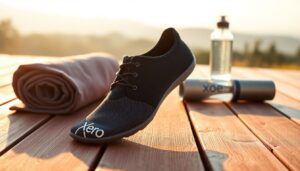
Top Recommendations for Yoga Practitioners
Not all barefoot shoes are equally suited for yoga and meditation. It is essential to find a pair that balances flexibility and grounding, allowing your feet to move naturally while ensuring stability. Seek models featuring thin soles for better proprioception and a wide toe box to support proper alignment—just like a yoga mat for your feet, providing the necessary support whilst keeping you connected to the ground.
Lightweight Z-Trail EV Sandals for Hot Yoga
In addition to your mat, the Z-Trail EV Sandals offer outstanding breathability and an incredibly lightweight feel, making them perfect for hot yoga or outdoor practices. With adjustable straps, they ensure a secure fit, while the zero-drop design promotes correct posture. However, be aware that their open style may not provide adequate warmth for cooler studios.
Versatile Prio Neo Shoes for Diverse Practices
Highly ranked among various yogis, the Prio Neo merges durability with a barely-there sensation. Its grippy sole prevents slips during dynamic flows, and the flexible upper adapts seamlessly to your foot’s movements. Ideal for both studio sessions and mindful strolls.
Users appreciate the Prio Neo for its versatility, although some note that the slightly thicker sole may diminish ground feedback compared to more minimalist options. If you value protection over ultra-thin sensitivity, this model excels—just be sure to break them in gradually to avoid stiffness.
Transforming Your Meditation Practice with Barefoot Shoes
Barefoot shoes act as a yoga mat for your feet, fostering a direct connection with the earth that enriches your meditation practice. This tactile feedback helps you remain present, effortlessly aligning your body and mind. The minimalist design encourages natural movement, enabling you to focus inward without distractions, thereby making each meditation session more immersive and grounding.
Grounding Effects for Enhanced Stability
Meditation necessitates stability, and barefoot shoes amplify this by heightening sensory input through your soles. Feeling the floor beneath you anchors your awareness, significantly reducing mental clutter. This physical connection reflects the mental stillness you aim to achieve, crafting a harmonious balance between your body and environment.
Boosting Mindfulness and Focus
To enhance your focus, barefoot shoes eliminate barriers between you and the ground, increasing proprioception. This awareness of your body’s position in space sharpens mindfulness, enabling you to detect subtle shifts in posture or breath. The result? A more profound, intentional meditation experience.
Grounding through barefoot shoes also minimises distractions caused by rigid soles or awkward foot positioning. When your feet are free, your mind follows suit, allowing you to settle into the present moment with ease. This synergy between body and mind facilitates a meditative state more naturally.
Encouraging Proper Posture and Spinal Alignment
Wearing barefoot shoes promotes proper weight distribution across your feet, which naturally aligns your spine. This alignment reduces strain on your lower back and hips, allowing for comfortable seating or standing during extended sessions. The outcome is a taller, more relaxed posture that supports deeper breathing.
Central to this benefit is the elimination of heel elevation, which is prevalent in traditional shoes and can tilt your pelvis forward. Barefoot shoes advocate a neutral stance, preventing slouching and permitting your spine to align naturally. This alignment not only enhances meditation but also helps to avert long-term discomfort.
The Science Behind Grounding Techniques
When you slip into barefoot shoes, your feet connect directly with the ground, enhancing sensory input and activating neural pathways linked to balance and awareness. This grounding effect, rooted in biomechanics, replicates the experience of walking barefoot, stimulating proprioceptors and improving posture. Research indicates that this connection can lower stress by reducing cortisol levels, making it particularly advantageous for yoga and meditation. Envision it as a yoga mat for your feet—supportive yet intricately connected to the earth beneath you.
Scientific Research on Sensory Feedback
Studies demonstrate that barefoot shoes enhance tactile feedback, boosting your body’s awareness during movement. A 2018 study revealed that participants wearing minimalist footwear displayed improved gait efficiency and increased sensitivity to various terrains. This aligns with yoga’s emphasis on mindfulness, aiding you in tuning into subtle shifts in weight and pressure to foster a deeper connection between mind and body.
The Impact on Proprioception and Balance
Sensory input from barefoot shoes sharpens proprioception—your body’s ability to sense its position in space. This is crucial for yoga poses requiring precision, such as Tree or Warrior III. By strengthening foot muscles and improving balance, you cultivate stability both on and off the mat.
For instance, a 2020 study indicated that users of minimalist footwear exhibited 19% better balance after 12 weeks compared to individuals wearing traditional shoes. This underscores how grounding practices can transform your yoga practice, minimising injury risk and enhancing fluidity.
Grounding Techniques for Stress Relief
In today’s hectic world, grounding through barefoot shoes offers a refuge. Direct contact with the earth can reduce stress hormones, promoting calmness during meditation. The tactile feedback serves as an anchor, drawing you into the present moment—crucial for mindfulness.
Research reveals that grounding practices, including earthing or minimalist footwear, can reduce inflammation and improve sleep quality. One study discovered a 30% reduction in cortisol levels among participants who engaged in grounding daily. For yogis, this translates to a quieter mind and a more resilient nervous system.
Personal Experiences with Barefoot Shoes in Yoga
Practitioners who have integrated barefoot shoes into their yoga routines consistently report a deeper connection to their practice. The thin, flexible soles function as a yoga mat for your feet, enhancing proprioception and grounding. Many find they can better align their posture and sense subtle shifts in balance, making poses such as Tree or Warrior feel more intuitive. Over time, your feet naturally strengthen, reducing reliance on artificial support and nurturing a more mindful practice.
Insights from Yoga Instructors on Barefoot Shoes
Instructors who have made the switch to barefoot shoes have noted enhanced stability in balancing poses. One teacher remarked that students felt more present during meditation, as the shoes eliminated distractions caused by rigid soles. The natural movement of the feet also alleviated strain during prolonged sessions, proving beneficial for both teaching and personal practice.
Improving Balance and Alleviating Fatigue
An immediate advantage of barefoot shoes is the heightened awareness of your foot placement, which sharpens balance. Their lightweight design mitigates fatigue, allowing you to maintain poses for longer durations without discomfort. As your arches and toes gain strength, strain during standing sequences diminishes.
Yoga practitioners often underestimate how traditional shoes can weaken foot muscles. With barefoot shoes, you reactivate these muscles, leading to better alignment and endurance. This transition can prevent injuries caused by overcompensation in the ankles or knees, making your practice safer and more sustainable.
Transitioning from Conventional Footwear to Barefoot Shoes
It is crucial to acknowledge that switching too rapidly to barefoot shoes may result in muscle soreness or discomfort. Initiate the transition with short sessions to allow your feet to adapt. Focus on gentle poses before advancing to more intense flows, giving your body the opportunity to acclimatise to the newfound freedom of movement.
Personal experiences highlight the importance of patience. While some individuals may experience immediate benefits, others may require weeks to fully adjust. Tune in to your body; if you encounter pain, reduce your intensity. The transition can reward you with stronger feet and a deeper mind-body connection, but rushing the process may lead to injury.
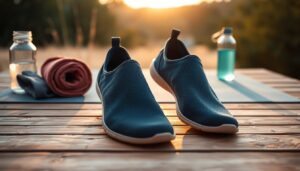
Selecting the Right Barefoot Shoe for Your Unique Needs
When choosing the ideal barefoot shoes, focus on flexibility, ground feel, and minimal cushioning. Your shoes should reflect the natural movement of your feet, serving as a yoga mat for your feet—supportive yet connected to the ground. Prioritise a wide toe box to enable your toes to spread naturally, enhancing balance and stability during poses. Lightweight materials combined with a zero-drop sole will ensure proper alignment, helping you remain grounded in both yoga and meditation.
Customising Your Shoe Choice Based on Your Practice Environment
Consider the environment in which you practice to tailor your shoe selection accordingly. For indoor studios, thin-soled options provide maximum sensory feedback, while outdoor sessions may necessitate slightly more durable soles to navigate uneven surfaces. If you practice on hardwood or tile floors, adequate grip is essential to prevent slipping during transitions.
Assessing Comfort and Fit for Optimal Performance
Evaluating comfort starts with trying on shoes and moving as you would during practice. Your toes should have sufficient room to expand, and the shoe should feel like a second skin—snug without being restrictive. Avoid any footwear that pinches or rubs, as discomfort can disrupt your focus.
A well-fitting barefoot shoe enhances your posture and alleviates strain. Proper fit promotes natural foot mechanics, helping to avert long-term issues such as bunions or plantar fasciitis. Test the shoes with dynamic movements to ensure they remain secure without constricting.
Choosing the Right Materials and Design for Your Barefoot Shoes
The materials you select significantly influence breathability and flexibility in barefoot shoes. Seek out natural fibres like organic cotton or hemp, which wick moisture and conform to your foot’s shape. Synthetic blends may offer durability but can trap heat, disrupting comfort during extended sessions.
Design also plays a pivotal role in performance. A seamless interior reduces irritation, while a flexible sole allows for unrestricted movement. Avoid stiff or overly structured designs, as they contradict the advantages of barefoot footwear. Opt for shoes that enhance, rather than hinder, your connection to the earth.
Dispel Common Myths Surrounding Barefoot Shoes
Numerous misconceptions exist about barefoot shoes, often deterring individuals from experimenting with them. Some believe they are solely for athletes or that they lack adequate protection; however, these shoes are crafted to enhance natural movement while causing minimal interference. Think of them as a yoga mat for your feet—supportive yet connected to the ground. Dispelling these myths allows you to make enlightened choices for your practice.
Are Barefoot Shoes Suitable for Everyone? A Closer Look
Myths may suggest that barefoot shoes are universally appropriate, but individual requirements can vary significantly. If you have severe foot conditions or rely on orthotics, consulting a specialist before transitioning is advisable. Nonetheless, many individuals find barefoot shoes beneficial for improving posture and balance, particularly in yoga and meditation.
The Misconception Regarding Insufficient Support
While adept at grounding, barefoot shoes do not lack support—they merely redefine what support entails. Rather than offering rigid arches, they promote your feet to strengthen naturally, much like how yoga enhances core stability. The thin sole safeguards your feet while permitting you to feel the earth beneath you.
Due to their design, these shoes encourage proper alignment and muscle engagement. Over time, this can lead to a decreased reliance on artificial support, yet transitioning too quickly may cause strain on unprepared feet. It’s crucial to heed your body’s signals and progress gradually.
Understanding the Necessity for Adaptation Time
When transitioning to barefoot shoes, your feet require time to acclimatise. Initial discomfort is typical as muscles and tendons adjust to newfound freedom. Start with short sessions during yoga or leisurely walks to avoid overexertion.
Patience is essential. Rushing the process can lead to injuries, while gradual use naturally strengthens muscles. Always consult a specialist if you experience chronic pain. Barefoot shoes, much like yoga, thrive on mindful progression.
Maintaining and Caring for Your Barefoot Shoes
Unlike traditional footwear, barefoot shoes require minimal yet thoughtful maintenance to preserve their flexibility and connection to the ground. Treat them as a yoga mat for your feet—supportive yet intimately connected to the earth. Regular care ensures they remain comfortable and functional, thereby enhancing your practice.
Cleaning and Storage Techniques for Longevity
Following a session or around the house, gently brush off dirt with a soft cloth and use mild soap for thorough cleaning. Avoid harsh detergents or machine washing, as these can impair the natural materials. Air-dry your shoes away from direct heat and store them in a cool, dry location. This simple routine keeps your shoes fresh and ready for your next practice.
Ensuring Longevity and Durability of Your Barefoot Shoes
How you store your barefoot shoes can affect their lifespan. Keep them in a well-ventilated area to prevent moisture build-up, which can damage the materials. If possible, alternate between pairs to reduce wear and tear.
Additionally, routinely check the soles and uppers for signs of thinning or damage. Proper care will help your shoes retain their grounded feel, supporting your practice for years to come.
Identifying When to Replace Your Barefoot Shoes
Barefoot shoes lose their efficacy once the soles become overly thin or the structure distorts. If you observe reduced grip or discomfort during poses, it’s time for a new pair. Worn-out shoes can jeopardise your alignment and connection to the ground.
Generally, replacing them every 6-12 months with regular use ensures optimal support. Neglecting wear can lead to strain or injury, making it crucial to heed both your body and your footwear.
Incorporating Barefoot Shoes into Your Daily Routine
Now that you've experienced the grounding advantages of barefoot shoes during yoga and meditation, consider integrating them into your everyday activities. Start by wearing them for brief walks or errands, allowing your feet to adjust gradually. Over time, your muscles and posture will strengthen, enhancing your connection to the earth. Visualise them as a yoga mat for your feet—supportive yet connected to the ground, helping you maintain mindfulness even beyond the mat.
Transitioning to a Barefoot Lifestyle
Transitioning from cushioned shoes to barefoot footwear necessitates patience. Begin with 30-minute sessions, gradually extending wear time to prevent strain. Listen to your body; discomfort signifies adjustment rather than failure. This shift reawakens your foot’s natural mechanics, fostering balance and resilience.
Exploring Activities Beyond Yoga and Meditation
Are you passionate about hiking, running, or gardening? Barefoot shoes shine in various settings. Their flexible soles and spacious toe boxes support natural movement, minimising injury risk while keeping you grounded. Whether on trails or city streets, they seamlessly blend barefoot freedom with essential protection.
Even daily chores present opportunities to enhance your feet. Walking barefoot-style indoors or during light workouts enhances proprioception, sharpening your awareness of body alignment. Over time, you may notice increased agility and a reduced dependency on artificial support.
Promoting Overall Foot Health with Barefoot Shoes
Switching to barefoot shoes can alleviate common foot issues like plantar fasciitis or bunions by encouraging proper toe splay and arch engagement. Unlike traditional shoes, they do not compress or weaken your feet, promoting long-term mobility.
Barefoot footwear also stimulates nerve endings, enhancing circulation and sensory feedback. This isn’t solely about comfort; it’s a preventive strategy against chronic pain. However, consult a specialist if you have existing conditions to ensure a safe transition.
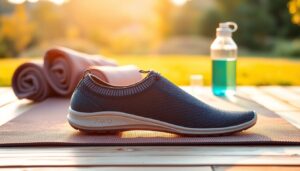
Expert Opinions on Barefoot Shoes
Despite varying viewpoints, experts generally agree that barefoot shoes can enhance your yoga and meditation practice by promoting natural movement and grounding. Research indicates they may improve proprioception, connecting you more deeply to the earth—like a yoga mat for your feet. However, transitioning too quickly can strain your muscles, making gradual adaptation paramount.
Insights from Experienced Yoga Professionals on Barefoot Shoes
Barefoot shoes are frequently praised among yoga instructors for their minimalist design, facilitating freedom of movement while maintaining stability. Many instructors note that these shoes promote better alignment and balance, although some advise caution against relying on them if you are new to barefoot practices.
Comments from Foot Health Specialists
Podiatrists suggest that barefoot shoes can strengthen foot muscles and improve arch support over time. However, they also caution that improper use may result in injuries like plantar fasciitis, especially for those with pre-existing conditions.
Expert guidance stresses beginning with short sessions and selecting shoes with flexible soles to mirror natural foot movements. Combining barefoot shoes with foot exercises can optimise benefits while minimising risks.
Feedback from Meditation Practitioners on Barefoot Shoes
Many yoga and meditation enthusiasts consider barefoot shoes a valuable tool for deepening their mindfulness practice. The direct contact with the ground fosters a sense of presence, although some practitioners prefer an entirely barefoot experience for maximum sensory feedback.
Experts emphasise that while barefoot shoes can enrich your practice, listening to your body is crucial. If discomfort arises, temporarily reverting to traditional footwear may be prudent. The ultimate goal is to achieve balance—supporting your feet while maintaining connection.
Addressing Common Inquiries Regarding Barefoot Shoes
After exploring barefoot shoes for yoga and meditation, you might still have lingering questions. Many practitioners seek clarity on transition periods, benefits for alignment, or how these shoes enhance mindfulness. Barefoot shoes act as a yoga mat for your feet, providing support while keeping you grounded. Whether you are a novice or experienced practitioner, understanding these details can enrich your experience.
Contrasting Barefoot Shoes with Traditional Yoga Footwear
The differences between barefoot shoes and conventional yoga footwear are evident. Here’s a quick comparison:
| | | High, mimics natural foot movement | Often restrictive, with thicker soles | Enhances sensory connection | Reduces tactile feedback | Strengthens foot muscles | Provides artificial arch support
Helpful Tips for Beginners Transitioning to Barefoot Shoes
To ease into wearing barefoot shoes, take a gradual approach. Focus on short sessions, ensure a proper fit, and prioritise listening to your body. Gradual adaptation is paramount to preventing discomfort.
Beginners frequently underestimate the importance of foot strength. Here are some beneficial exercises:
- Strengthen arches through toe spreads and lifts
- Walk on varied surfaces to build resilience
- Monitor your progress to avoid overuse
Patience can lead to significantly improved outcomes.
Addressing Concerns Regarding Foot Health
A common worry is whether barefoot shoes could harm your feet. Research indicates they enhance posture and reduce joint strain when used properly. However, pre-existing conditions like plantar fasciitis may necessitate additional care.
Another critical aspect is safe transitioning. Hurrying can lead to injury, while gradual use naturally fortifies muscles. Always consult a specialist if you experience persistent pain. Barefoot shoes, much like yoga, thrive on mindful progression.
Important Considerations When Purchasing Barefoot Shoes
Bear in mind that barefoot shoes should closely resemble the natural shape of your foot, featuring a wide toe box and a flexible sole. Seek breathable materials like organic cotton or recycled synthetics to enhance comfort during yoga and meditation. Prioritise brands that align with your values, whether it’s sustainability, durability, or minimalist design. Testing the fit is vital—your toes should have room to splay, and the sole should feel like a yoga mat for your feet, supportive yet connected to the ground.
Where to Find Quality Barefoot Shoes
The best places to shop for barefoot shoes include specialty footwear stores, eco-conscious boutiques, and online retailers. Brands such as Vivobarefoot, Xero Shoes, and Merrell provide dedicated collections tailored to mindful movement. If you prefer trying shoes on before purchasing, visit local stores that specialise in minimalist footwear. For a broader selection, online marketplaces like Amazon or brand websites often offer detailed sizing charts and customer reviews to assist you in making an informed decision.
Evaluating Online vs. In-Store Shopping Options
Every purchase decision involves weighing convenience against tactile experience. Online shopping typically offers a wider range and often better prices, but you miss the opportunity to feel the shoes firsthand. In-store purchases enable you to assess fit and flexibility immediately, ensuring that the shoes meet your yoga and meditation requirements. Consider these factors based on your priorities—speed, variety, or immediate feedback.
For those familiar with a brand, online shopping can be ideal, especially if you rely on detailed sizing charts. However, if you are new to barefoot shoes, visiting a store can prevent costly mistakes. Some retailers offer free returns, bridging the gap between online and in-store options. Always review return policies before making an online purchase to avoid unexpected surprises.
Balancing Pricing and Budgeting Considerations
When investing in barefoot shoes, strive for a balance between quality and affordability. Prices can range from $50 for budget-friendly options to over $200 for premium, sustainably-made selections. Establish a budget that reflects your commitment to grounding practices—consider it an investment in long-term foot health rather than mere footwear. Look for seasonal discounts and sales to acquire high-quality pairs without overspending.
Your spending priorities matter. Premium brands frequently utilise eco-friendly materials and superior craftsmanship, justifying a higher price point. However, mid-range options can still deliver excellent comfort and durability. Avoid the cheapest choices if they compromise on flexibility or toe space, as poorly fitting shoes can hinder your practice and potentially cause discomfort over time.
Continuing Your Journey with Barefoot Shoes
In summary, barefoot shoes can significantly enhance your yoga and meditation practice by fostering a deeper connection to the earth, functioning as a yoga mat for your feet—supportive yet firmly grounded. These minimalist footwear options improve proprioception, balance, and alignment, helping you remain present in your movements and breathwork. By embracing barefoot shoes, you honour the natural biomechanics of your feet, rooting your practice in both physical and mindful awareness. Whether on the mat or during meditation, this subtle shift can amplify your sense of stability and harmony, aligning body and mind with each step.
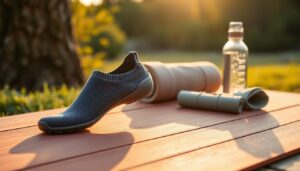
Frequently Asked Questions Regarding Barefoot Shoes
How do barefoot shoes enhance the yoga and meditation experience?
Barefoot shoes serve as a yoga mat for your feet—supportive yet firmly connected to the ground. They facilitate natural foot movement, improving balance and proprioception during poses. Their thin, flexible soles allow you to feel the floor beneath you, deepening your mind-body connection and grounding your practice.
Are barefoot shoes suitable for all types of yoga?
Yes, barefoot shoes are appropriate for most yoga styles, from gentle Hatha to dynamic Vinyasa. Their lightweight design and flexible soles replicate the benefits of practising barefoot while offering essential protection. For hot yoga, opt for breathable materials like merino wool or mesh to ensure comfort and hygiene.
What should I prioritise when selecting barefoot shoes for meditation?
Look for a wide toe box to enable your toes to spread naturally, akin to roots grounding into the earth. Choose zero-drop soles to maintain correct posture during seated meditation. Soft, flexible materials enhance tactile feedback, allowing you to remain present—consider them an extension of your mindful awareness.
The Article Barefoot Shoes for Yoga and Meditation: Grounding Your Practice appeared first on My Shoes Finder
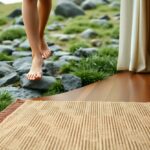

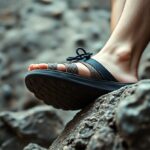
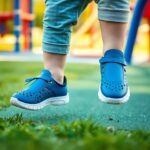
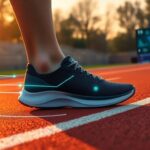

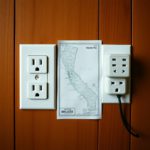
Your perspective on the importance of footwear in yoga and meditation practices is certainly thought-provoking. The idea of barefoot shoes acting as a “yoga mat for your feet” resonates deeply with me, especially as I’ve found that my own yoga experience improves significantly when I feel more connected to the ground beneath me.
It’s interesting that you bring up the connection to the ground in yoga. That sense of grounding can really shape your practice. However, while barefoot shoes can enhance that connection, it’s also worth considering how much our practices depend on individual needs and preferences. Some people thrive in a more cushioned environment, while others truly benefit from minimalistic footwear.
It’s interesting to hear how your connection to the ground influences your yoga practice. The concept of footwear acting like a “yoga mat for your feet” really speaks to the way we interact with our environment. When we wear shoes that allow our feet to move naturally, it can enhance our balance and stability, essential elements in yoga and meditation.
I’m glad you found that perspective compelling! If you’re interested in exploring barefoot shoes that enhance your connection to the ground, check out this link for some great options.
https://officialpropertytwins.com/ChocolateHealth